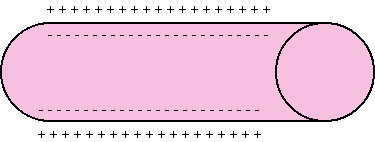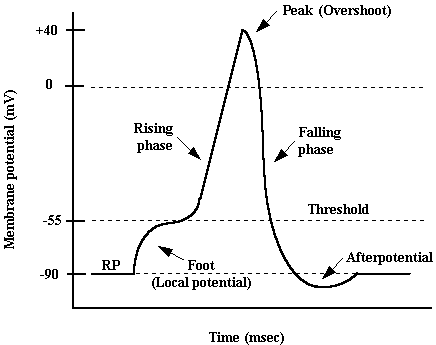Nerve cells (neurons) carry information when action potentials travel along their axons. The action potential may be described as a"wave" of electrical activity. However, although charged particles move during an action potential, the process is not the same as the way electricity travels along a wire:
Neurons
To show just what an action potential involves, it is first necessary to examine the properties of the cell membrane surrounding the axon. The membrane of the axon, like the membrane of most cells, is capable of carrying out active transport. There is a"pump" present in the membrane that actively transports sodium ions out of the cell and actively transports potassium ions into the cell.
- The nerve impulse is slower
- Electrical wires carry moving electrons; axons carry moving ions
- Ions do not move from one end of the neuron to the other -- since neurons may be several centimeters long, it would take
hours for ions to diffuse from one end to the other.Recall that sodium (Na) and potassium (K) exist as positively-charged ions in solution, i.e., as Na+ and K+. Since these two ions have relatively small hydrated ionic radii, they are able to"leak" through the cell membrane by diffusing through membrane pores.
The following situation exists in a nerve axon:
- The membrane"pump" pumps Na+ out and K+ in.
- Both Na+ and K+ can leak through the membrane.
- Both Na+ and K+ ions are positively-charged.
- The membrane permeability to K+ is 100X greater than the permeability to Na+.
Let's suppose that we start with a nerve cell sitting in a large bath of extracellular fluid that contains 4 mM K+ and 145 mM Na+. Suppose that the membrane pump has been turned off for a long time, and the concentration of Na+ and K+ inside the cell are the same as the concentrations in the extracellular fluid.
Resting Potentials

The main negative ions inside the axon are large protein molecules that are too large to diffuse through membrane pores. In the extracellular fluid, the main negative ions are chloride ions.Inside the cell, the number of negative charges (on the protein) is equal to the number of positive charges, and the same situation is true in the extracellular fluid -- the number of negative charges equals the number of positive charges.
Our starting conditions, then, are the following:
|
|
|
|
|
|
|
|
|
|
|
|
|
|
|
Now, let's turn on the pump and let it run for a short time. Suppose that it pumps 1000 Na+ ions and 1000 K+ ions.

The activity of the pump results in the following changes:
|
|
|
|
|
huge bath of extracellular fluid and the K+ lost and Na+ added are insignificant. |
|
|
|
|
|
After the pump has been working for a while, the K+ concentration inside the cell is slightly higher than it is outside, and the Na+ concentration is slightly less than it is outside -- this means that there is now a concentration gradient for these two ions!As a result, K+ ions will tend to diffuse (leak) out of the cell, and Na+ ions will tend to leak into the cell. However, recall that it is 100x easier for K+ to diffuse through the membrane. Hence, in a given time interval, the number of K+ ions that leave the cell will be100X greater than the number of Na+ ions that leak in.
If this happens, what will the result be? Since both Na+ and K+ are positively-charged ions, if the pump pumps in 1000 K+ ions, and 100 of them leak back out -- and if it pumps out 1000 Na+ ions, and only 1 leaks back in, the result is that the inside of the cell has lost 99 positive charges. In other words, the inside of the axon now has an excess of negative charges.
The extracellular fluid started out with equal numbers of + and - charges, and now it has gained 99 positive charges.
Inside Outside Due to pump Loses 1000 Na+ Gains 1000 Na+ Gains 1000 K+ Loses 1000 K+ : The pump does not change the number of charges inside or outside! Due to leak Gains 1 Na+ Loses 1 Na+ Loses 100 K+ Gains 100 K+ Summary Net loss of 99 + charges Net gain of 99 + charges
To summarize, the action of the pump causes the inside concentration of Na+ to be reduced and the inside concentration of K+ to be increased. The leak causes the inside to lose positive charges (have an excess of negative charges) and causes the outside to gain positive charges.Because the separated charges attract each other, they will get as close as possible. The negative charges will spread out over the inside of the axon membrane and the positive charges will spread out over the outside of the axon membrane.

What happens as time goes on? Does the number of extra negative charges inside and the number of extra positive charges outside keep increasing forever? No! The difference all began because it was easier for K+ to leak out than it was for Na+ to leak in. Since unlike charges attract each other, as the number of negative charges inside the membrane increases, they will attract the Na+ ions from the extracellular fluid. As charge builds up inside the cell, the leak of Na+ into the cell will keep increasing because Na+ ions are acted upon by both a concentration gradient and the increasing electrical gradient of the negative charges inside the cell.
The reverse situation is true for K+ ions. As the pump works, the concentration gradient for K+ keeps increasing also, but the buildup of positive charges outside the axon makes it difficult for K+ to leave.
At the beginning, the leak of K+ out was greater than the leak of Na+ in. As time goes on, the inward leak of sodium increases and the outward leak of potassium decreases because of the charge difference across the membrane. A point will be reached where the leaks are equal, and the cell will be in a steady-state. The final concentrations of ions will be the following:
|
|
|
|
|
|
|
|
|
|
|
|
Because of the charges that build up on axon membranes (and other cell membranes as well), it is possible to measure a voltage of about 90 mV across the membrane. This voltage is usually referred to as -90 mV, the minus sign reflecting that the inside of the cell is negative.Inactive neurons are polarized in just this way — there is a potential difference (voltage) between the inside and outside of the cell because of the properties of the membrane. This is called the resting potential.
Under certain conditions, neurons are stimulated to transmit information. When a neuron receives an adequate stimulus (a threshold stimulus), the properties of the membrane suddenly change. The resting membrane, as we have seen, is more permeable to K+ than to Na+. In the presence of a threshold stimulus, the membrane becomes more permeable to Na+ than to K+. In other words, the properties that gave rise to the resting potential are suddenly reversed.
Action Potentials
As Na+ ions find it easier to penetrate the membrane, a small amount of Na+ rushes into the cell, drawn by the concentration gradient and by the excess negative charges inside. This change in membrane properties is very abrupt and short-lived, and in less than 1 millisecond, enough Na+ enters the axon to reverse the charge on the inside from negative to positive.

The whole process is over in a few milliseconds, and the membrane once again becomes more permeable to K+ than Na+, and it returns to its resting state. A single action potential of this type does not lead to any measurable change in the concentration of sodium and potassium inside the cell, since only a few ions have to move to cause a large voltage change.During the action potential, then, the voltage across the membrane changes from -90 mV to about +40 mV and then back to -90 mV again. Thus, action potentials have the following parts:

It is not known exactly how the membrane is able to change its permeability properties so rapidly and strikingly; one suggestion is that new Na+"channels" or"pores" open briefly. In any case, the membrane responds to small depolarizations of the membrane. Such depolarizations can be brought about by the action of sensory receptors or by synaptic transmission from other nerve cells.Once part of the axon "fires" an action potential, that part changes its voltage, and adjacent resting membrane regions become depolarized.

Positive charges from the outside of the resting region will be attracted by adjacent negative charges in the active region, and positive charges on the inside of the active region will be attracted by adjacent negative charges. This charge movement reduces the resting potential on adjacent membrane and therefore depolarizes it.

As the adjacent resting region is depolarized to"threshold," its membrane properties change and it also fires an action potential. This is why action potentials are referred to as"waves" of electrical activity.
What we have discussed so far occurs in axons that are not wrapped in myelin. The thick wrapping of myelin in a myelinated axon acts as an insulator and prevents ions from entering or leaving the axon. However, at nodes of Ranvier, where the myelin wrapping is absent, an action potential can be fired. Since the area of membrane adjacent to the node is myelinated, ions move from node to node. This type of action potential conduction is called saltatory conduction, and, because the action potential"jumps" from node to node, it can move along the axon much faster than in an unmyelinated axon. Where rapid transmission of information is important (e.g., pain pathways), axons are myelinated; where speed of transmission is unimportant, axons are unmyelinated.
Saltatory Conduction
Ion Channels
There are several types of membrane channels (complex protein molecules) which allow ions to move from one side of the membrane to the other side. They are found in neurons & muscle fibers, and they change membrane permeability and membrane potential in response to stimuli. The opening of a K+ channel hyperpolarization (when K+ leaves or Cl- enters), and the opening of a Na+ channel depolarization (when Na+ enters). There are three types of gated ion channels:
Voltage-regulated - open & close in response to changes in membrane potential
- found in excitable membranes (capable of undergoing APs)
- have 2 gates: activation gate (opens channel) & inactivation gate (closes channel)Chemically-regulated - open & close in response to transmitter-receptor interactions
- may either depolarize (excite) or hyperpolarize (inhibit)
- also called ligand-regulated channels
- lead to:EPSP's - excitatory postsynaptic potentials IPSP's - inhibitory postsynaptic potentials
- allow Na+ to enter - allow K+ to leave or Cl- to enter
Mechanically-regulated - open & close in response to physical distortion of membrane surfaceEPSP's and IPSP's are graded potentials - their size is proportional to the amount of
transmitter released. EPSP's and IPSP's can summate to produce larger potentials, and, at
any instant, an axon hillock's membrane potential is an integrated average of the summed
EPSP's and IPSP's impinging on it.
- found in sensory receptors